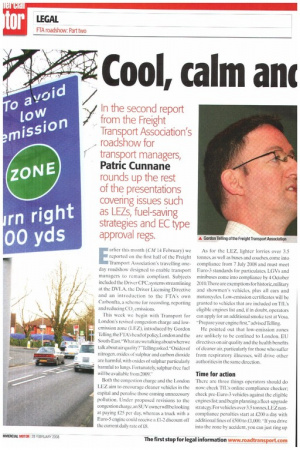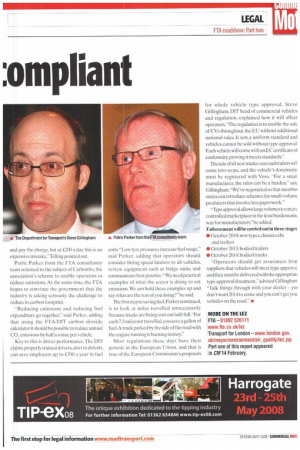Cool, calm an
Page 26

Page 27

If you've noticed an error in this article please click here to report it so we can fix it.
vmpilanit
In the second report from the Freight Transport Association's roadshow for transport managers, Patric Cunnane rounds up the rest of the presentations covering issues such as LEZs, fuel-saving strategies and EC type approval regs.
Earlier this month (CM 14 February) we reported on the first half of the Freight Transport Association's travelling oneday roadshow designed to enable transport managers to remain compliant. Subjects included the Driver CPC,systems streamlining at the DVLA. the Driver Licensing Directive and an introduction to the ETA's own Carbonfta, a scheme for recording, reporting and reducing CO. emissions.
This week we begin with Transport for London's revised congestion charge and lowemission zone (LEZ), introduced by Gordon Telling,the ETA's head of policy; London and the South-East."What arc we tal king about when we talk about air quality?-Telling asked."Oxides of nitrogen, oxides of sulphur and carbon dioxide are harmful, with oxides of sulphur particularly harmful to lungs Fortunately, sulphur-free fuel will be available from 2009:' Both the congestion charge and the London LEZ aim to encourage cleaner vehicles in the capital and penalise those causing unnecessary pollution. Under proposed revisions to the congestion charge,an SUV owner will he looking at paying £25 per day, whereas a truck with a Euro-5 engine could receive a £1-2 discount off the current daily rate of 18. As for the LEZ, lighter lorries over 3.5 tonnes, as well as buses and coaches, come into compliance from 7 July 2008 and must meet Euro-3 standards for particulates. LGVs and minibuses come into compliance by 4 October 2010.There are exemptions for historic, military and showmen's vehicles, plus all cars and motorcycles. Low-emission certificates will be granted to vehicles that are included on TfL's eligible engines list and, if in doubt, operators can apply for an additional smoke test at Vosa. "Prepare your engine first,advised Telling.
He pointed out that low-emission zones are unlikely to be confined to London. EU directives on air quality and the health benefits of cleaner air, particularly for those who suffer from respiratory illnesses, will drive other authorities in the same direction.
Time for action
There are three things operators should do now: check Tfrs online compliance checker; check pre-Euro-3 vehicles against the eligible engines list; and begin planning a fleet-upgrade strategy. For vehicles over 3.5 ton nes.LEZ noncompliance penalties start at £200 a day with additional fines of £500 to £1,000. "If you drive into the zone by accident, you can just ring up and pay the charge, but at £200 a day this is an expensive mistake,"Telling pointed out.
Patric Parker from the FTA consultancy team returned to the subject of Carbonfta, the association's scheme to enable operators to reduce emissions. At the same time, the FTA hopes to convince the government that the industry is taking seriously the challenge to reduce its carbon footprint.
" Reducing emissions and reducing fuel expenditure go together," said Parker, adding that using the FTAIDfT carbon dioxide calculator it should be possible to reduce annual CO, emissions by half a tonne per vehicle.
Key to this is driver performance. The DfT claims properly trained drivers, alert to defects, can save employers up to £700 a year in fuel costs. "Low tyre pressures increase fuel usage," said Parker, adding that operators should consider fitting speed limiters to all vehicles, review equipment such as fridge units, and communicate best practice." We need practical examples of what the sector is doing to cut emissions. We can hold these examples up and say, what are the rest of you doing?" he said.
The first step to saving fuel. Parker continued, is to look at miles travelled unnecessarily because trucks are being sent out hall-full. "For each 7.5 miles not travelled,you save a gallon of fuel.A truck parked by the side of the road with the engine running is burning money."
Most regulations these days have their genesis in the European Union, and that is true of the European Commission's proposals for whole vehicle type approval. Steve Gillingham, EMT head of commercial vehicles and regulation, explained how it will affect operators "The regulation is to enable the sale of CVs throughout the EU without additional national rules. It sets a uniform standard and vehicles cannot be sold without type approval Each vehicle will come with an EC certificate oi conformity, proving it meets standards."
The sale of all new trucks.vans and trailers wit come into scope, and the vehicle's document! must be registered with Vosa. -For a smal manufacturer, the rules can be a burden," saic Gillingham."We've negotiated so that membei states can introduce schemes for small-volume producers that involve less paperwork."
-Type approval allows large vol umes to enter controlled marketplace in the least burdensom( way for manufacturers," he added.
Enforcement will be carried out in three stages • October 2010: new types, chassis cabs and trailers • October 2013: bodied trailers • October 2014: bodied trucks -Operators should get assurances fron suppliers that vehicles will meet type approval and they must be delivered with the appropriati type approval document," advised Gillingharr "Talk things through with your dealer yoi don't want 201410 come and you can't get you vehicles on the road.m




































































































































































